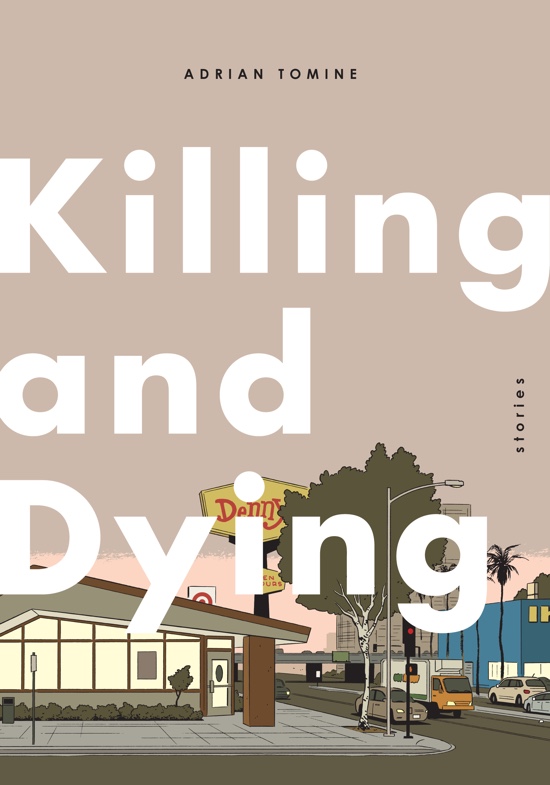Somewhere online I recently saw the observation that the comics release schedule is similar to the film schedule – blockbusters in the summer, and higher quality fare getting the autumn releases. That’s borne out to some degree by the sheer quality of the books I’ve been looking at recently (although I’ve also got a few here that I’m catching up on from earlier in the year). Great stuff lined up for next time, too.
One of the biggest current releases is the new Adrian Tomine, Killing And Dying, reviewed below. I’m particularly excited by this as I stumbled upon Gosh Comics in 2007 at their old location, while waiting to go to the British Museum, and rekindled my reasonably dormant interest in comics with a bag full of Tomine, Chris Ware and Yoshihiro Tatsumi, all of whom were new discoveries for me. Tomine fans in the UK are particularly well served at the moment as Faber has just followed his new book with a softcover edition of his brilliant New York Drawings.
I’ve also been blown away by a bunch of Frontier that Youth In Decline was kind enough to send, including a couple of the finest single story single issue comics I can remember reading. No wonder Jillian Tamaki won an Ignatz for her volume. (These are available online from Youth In Decline, and also at Gosh Comics in London and First Age Comics in Lancaster.)
This month we welcome a new writer to the team, Jenny Robins, who reviews The Rabbit below.
Adrian Tomine – Killing And Dying (Faber & Faber – UK, Drawn & Quarterly – North America)
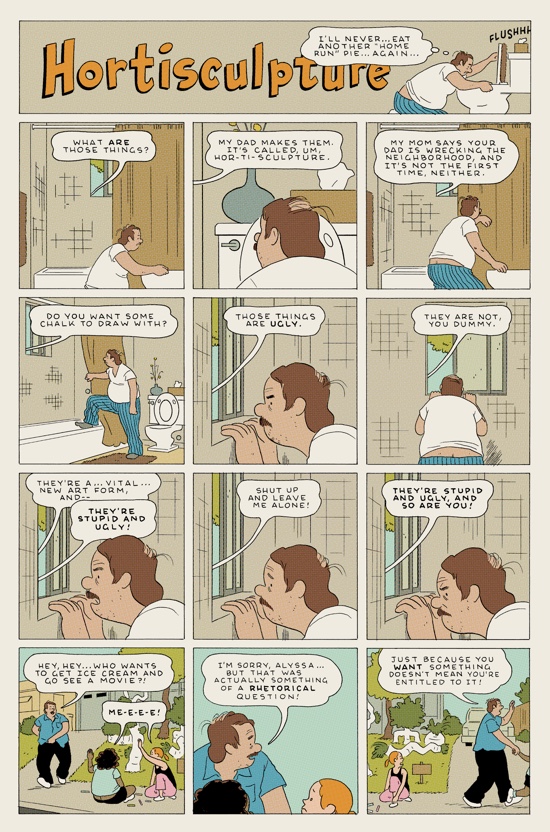
A new Adrian Tomine book is a big deal. It’s been eight years since his last full-length, Shortcomings, and although there have been a couple of smaller items and individual issues of Optic Nerve, this feels long overdue. First impressions are great – a stunningly presented hardcover in a transparent plastic dust jacket, a taste of the meticulous contents within. It’s a collection of six stories from Optic Nerve #12-14, with his clean, precise artwork now in colour.
It’s been so long since Shortcomings that it’s easy to think Tomine must be over hyped – that he can’t really deserve all the praise he’s currently getting. And then you start reading, and you remember that it’s not hype at all. He really is that good. Tomine has an unusual ability to convey emotion through the most subtle of details, drawing the reader in and the characters in these stories are so convincing that you can often see from afar the hopes that will be dashed; the defeats life will deliver to the woman in Go Owls as she hooks up with the new boyfriend who looks like a Douglas Coupland gone to seed, to the married couple in A Brief History Of The Art Form Known As "Hortisculpture". These quietly heartbreaking scenes in small lives delivered with such economy, in both the art and the writing. To discuss specific details would be to spoil the story, but the interactions between the father and the daughter in the title story Killing And Dying are devastatingly honest. He’s matured significantly as a writer in recent years, no doubt partly as a result of becoming a parent: a theme that runs through many of the stories here.
His artwork shows similar development, too, although the gorgeous full colour used in several of the stories here does seem more familiar due to his widely seen illustration work and New Yorker covers. It’s something of a shock to revisit his earlier comics and see that it’s all black and white – this presentation seems so natural. Translated From The Japanese most closely matches the style of those aforementioned New Yorker works, and is the only piece here that is drawn entirely as point of view images, without the protagonist being depicted at all.
There’s an ambiguity to all the endings here, with Tomine allowing us to draw our own conclusions about what happens after the final panels, and to take from the stories something of what we bring to it ourselves. Killing And Dying is a masterpiece. You should buy this book. Pete Redrup
Various – Frontier #6-9 ( Youth In Decline)
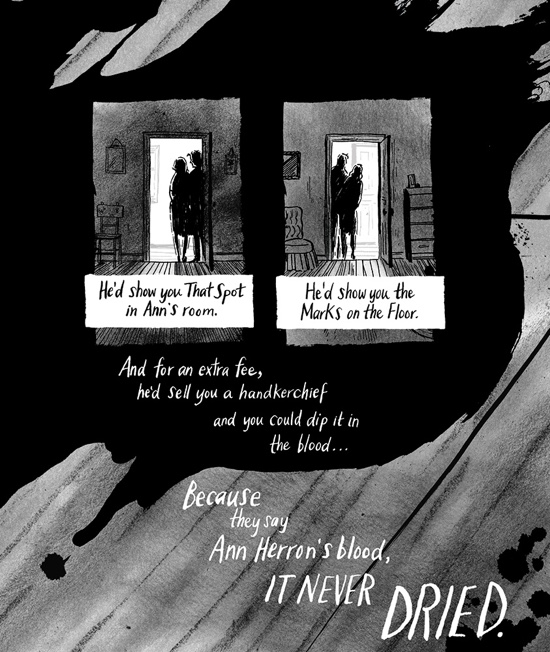
Frontier #6 – Ann By The Bed by Emily Carroll – is a year old, so this is a very late review. Most horror isn’t actually scary – Carroll and Josh Simmons are perhaps the only exceptions, and their work couldn’t be more different. This is a classic ghost story, with beautifully fluid artwork; the page layouts are brilliant, with softly delineated panels of various shapes and sizes set against disturbing background images, the story switching between then and now, with pale colour signifying the present and brutal monochrome the past. As always, her art, her lettering and her pacing are flawless, and this grips to the last, terrifying page. There is no finer cartoonist producing this type of horror, and this is a great companion piece to her Ignatz Award-winning Through The Woods.

Are you a nerd? Early days of the internet? IRC and newsgroups? If so, before Frontier #7 even starts, you’ll be won over by the hand-drawn ASCII art picture of Jillian Tamaki, and the rest of the comic will not disappoint. SexCoven is a brilliant blend of internet legend and sex cult implosion, full deserving the Ignatz Award it won for Best Story. It’s about a piece of music, found on a filesharing site, and the effect it has on listeners. Readers of tQ should be down with the idea that music can be transformative, addictive, all consuming, and Tamaki is too. She perfectly captures those days when the internet was not yet mainstream, and that feeling of belonging to an exclusive online community. So many details are just right, from the slightly aliased edges in some images to the software user interfaces she depicts, and both the story and the presentation are fantastic.
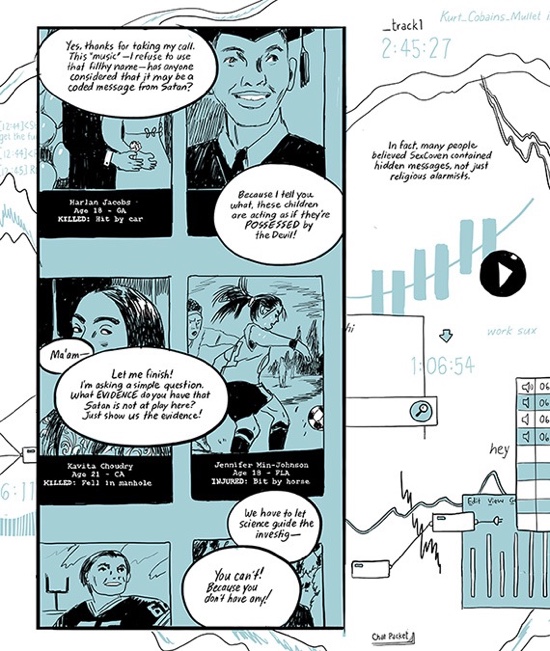
Frontier #8 is Anna Deflorian’s Faith In Strangers: a striking, experimental work about a couple of girls, the gym they go to, a lost phone and (and so on). The surly, dissatisfied faces of her characters portray little more than ennui – the only smiles in the whole comic appearing in a single panel, belonging to two passers-by on the street. Becca Tobin’s Frontier #9, however, couldn’t be more different – dreamy, organic watercolours telling the story of a band, disillusioned with fame and split by creative differences, who create a new member, Saltdough, out of eggs, nails and more. It’s as bizarre and original as it sounds.
With the next issue by Michael DeForge, Youth in Decline look set to continue this fantastic streak. Check them out, and if you see some, buy them – a couple of these are close to the end of the first edition runs. Pete Redrup
Edward Ross – Filmish (SelfMadeHero)
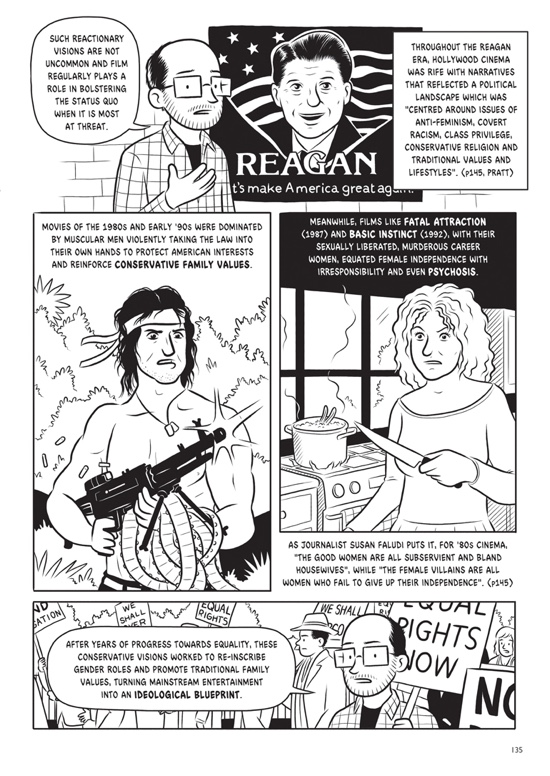
Edward Ross has been working on Filmish for years. It first appeared as four self-published issues subtitled ‘comic book essays on film theory’, now presented as ‘a graphic journey through film’. The material has been substantially reworked and expanded – the art is much more refined – and Ross now depicts himself with noticeably less hair. Causation or just correlation?
If you’ve read Scott McCloud’s famous Understanding Comics, the style will be familiar. Ross is depicted as a narrator figure, essentially delivering lectures about film. Comics are particularly well-suited to this sort of analysis as the artist can present shots from the films as well as images with the narrator in the place of an actor, making-of shots and more.
Of course there are countless introductions to the world of film, in a variety of formats, with many excellent books and documentaries covering some of the same ground. However, this is a hugely accessible presentation of this material, delivered in an engaging and witty style. Ross clearly has enormous passion for his subject.
The book is split into themed chapters. Ross starts with the eye, focusing on cinematography and editing, before moving onto what the eye sees, the body and then film sets. Towards the end we head into more polemical territory, with a couple of excellent chapters exploring power and ideology (with a focus on gender politics and a great analysis of Disney, among other things) and then the uneasy balance between technology and technophobia. The book then ends with an extensive section of endnotes.
There’s nothing effortless about a book like this, but Ross has managed to do something very difficult – he’s produced a book that is entertaining, informative and thought-provoking. If you’re interested in film, this is a must-buy. Pete Redrup
Jillian Tamaki – SuperMutant Magic Academy (Drawn & Quarterly)
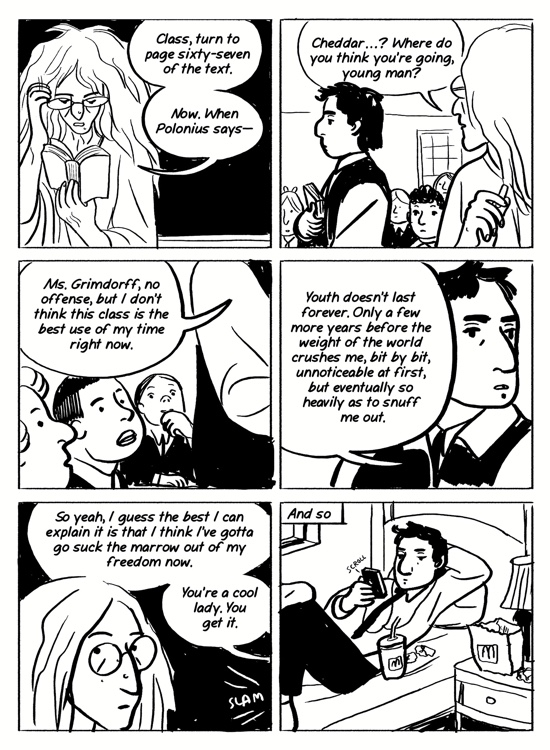
Jillian Tamaki’s SuperMutant Magic Academy collects pretty much all of her long-running webcomic of the same name, along with a new story at the end. It’s a sharp, witty portrayal of teen anxieties and behaviour transposed to a magical world. Set somewhere between Hogwarts and the North American high schools of so many TV shows and films, it’s hard to review this book without addressing the issue of the former. There are some obvious similarities – school of magic etc. – but the Harry Potter books just aren’t realistic. Perhaps, you might say, it’s misguided to expect realism in a book about a teenage wizard and his friends, but it’s not the wizard parts that are unrealistic, it’s the teenagers. Beyond the fact that Harry Potter was sometimes stubborn and colossally irritating, he just didn’t seem like a real teenage boy. This isn’t particularly meant as a criticism of JK Rowling, but it’s something Jillian Tamaki gets absolutely spot on: her characters seem like the genuine article. Apart from the mutants and magic angle, obviously. Tamaki’s teenagers deal with perennial issues such as unrequited crushes, sexism and coming out, as well as more contemporary ones such as sexting and social media. These kids are glued to their phones.
The book mostly consists of standalone pages with six black & white panels. As you’d expect from a webcomic, the art is less refined than in Tamaki’s previous book, but no less effective for that. These are quickly drawn pages that allowed her to relax from her precise illustration work, and the playfulness shows through. There are occasional flourishes of colour, the odd sequence spread over two pages, and some with four panels. Exclusive to this volume is the final section, more than 40 sequential pages chronicling the end of school, complete with the obligatory prom.
It takes real talent to create characters that are so well observed as well as entertaining. Deftly avoiding the cliches of high school and magical worlds, Tamaki has created something magical herself. Pete Redrup
Marc Bell – Stroppy (Drawn & Quarterly)
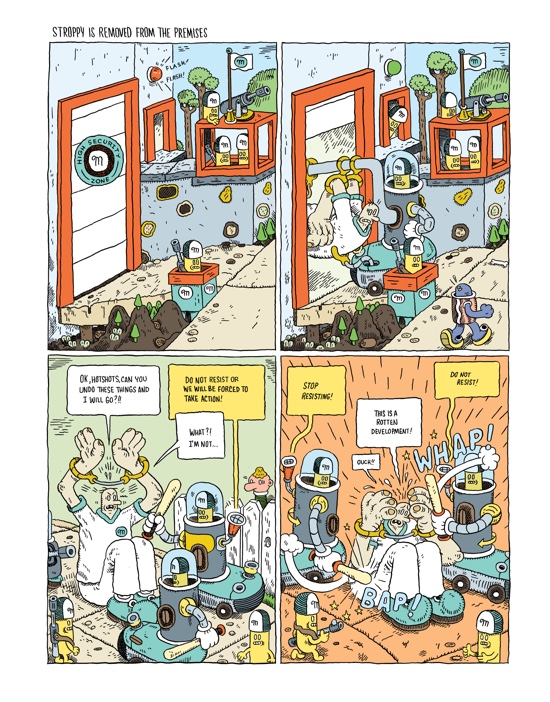
Marc Bell’s Stroppy is a deranged book that defies easy categorisation, and is full of densely layered social commentary. The central character Stroppy (last seen in Bell’s Pure Pajamas) is the victim of an unfair capitalist society. In the first few pages he loses his job through no fault of his own, and before too long has been beaten by private security goons and made homeless, naked, and left in debt (for the medical care the goons administer after their beating, amongst other things). Meanwhile the All-Star Schnauzer Band are running a songwriting competition which local oligarch (and Stroppy’s former employer) Monsieur Moustache is determined to win, and which leads to a power struggle. All-Star Schnauzer Band unpaid intern Sean, whose careless actions led to Stroppy’s unemployment, causes mayhem wherever he goes as he selfishly tries to further his own career regardless of the harm against others. Keeping up? The book is full of poems, song lyrics and countless pop culture references, and even features a greatest hits album in the form of a crazy golf course.
In a recent Inkstuds podcast Bell described his panels as vaudeville style not cinematic style – there are very few close ups, and the amount of detail he packs into each page is staggering – there are lots of things you only spot second time around. His instantly recognisable artwork is fantastic here, particularly on some of the later pages with just one panel rather than the four most often used. Artwork aside, whether you’d enjoy the story is likely to depend on your tolerance for the constant stream of absurdities, but if you immerse yourself in Stroppy’s world there’s plenty to savour. Pete Redrup
Rachael Smith, The Rabbit (Avery Hill)
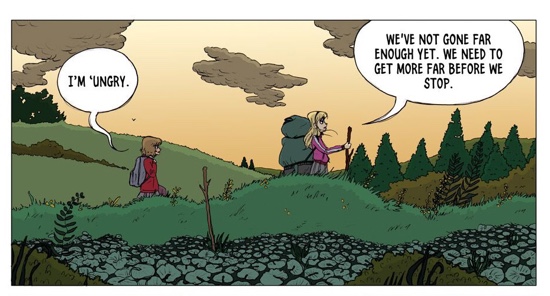
From the first pages of The Rabbit, Rachael Smith shows us poignantly blurred lines of fantasy and reality. The lush poetics of the establishing panels of a rural (but not that rural) British scene are contrasted both with the hyper-real colours of a fairy-tale fantasy and the very-much-real lives and dialogue of the two young characters Eleanor (14) and Kathy (9). At first this seems a straightforward comparison, but as the story continues the concerns and trials of the girls further blur the banal and surreal with increasingly complex metaphors that leave the reader unsure quite whose nightmare they are experiencing.
Having run away from home, Eleanor and Kathy seem to have no more complex aim than to get as far away as possible. When, reluctantly on Eleanor’s part, they include an injured baby rabbit in their quest he, Craig, develops the power of speech and an enormous appetite for junk food and gin. Craig’s speech is lettered in a childish scrawl with incomplete sentences, which implies that his transformation is largely the brainchild of the younger of the two girls. But in contrast to Eleanor’s imaginary candy coloured dragons and princesses that we see during the girls’ more escapist games, the titular Rabbit’s cave of wonders is altogether darker, and doesn’t go away when her phone rings. The artwork verges on the grotesque in places, as if the stories of Hayao Miyazaki were illustrated by Robert Crumb, not only eerily mythic but downright disturbing. I had nightmares after watching Watership Down when I was a grumpy and over-imaginative girl child myself, so am already susceptible to rabbit related horrors.
The relationship between the two central characters rings true enough, with Kathy’s inherent trust of her sister, despite her near constant controlling and bullying behaviour and Eleanor’s deeply protective instincts towards Kathy within her desperation to appear in control of events; So that we follow them down the Rabbit hole without hesitation although not, on my part, without trepidation. Jenny Robins
The Rabbit was nominated for Best Book at the British Comic Awards.
Scott Snyder / JOCK – Wytches Vol 1 (Image)
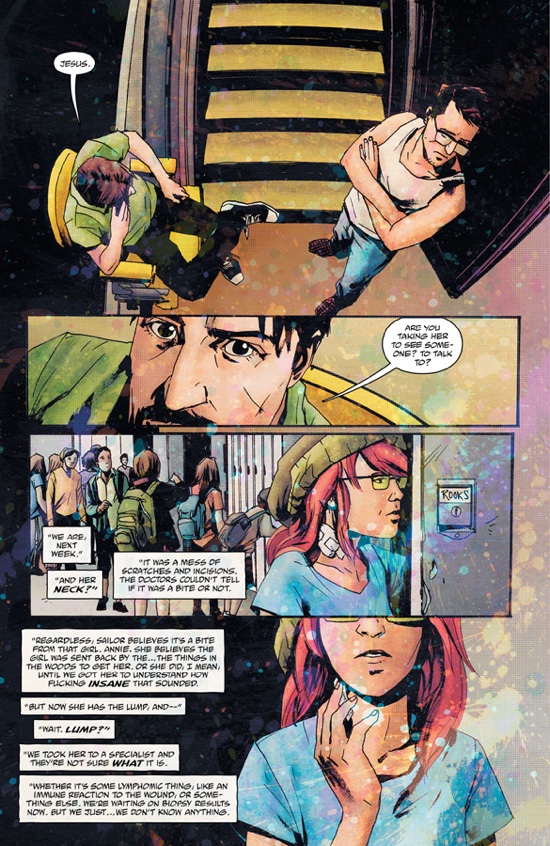
The clocks go back, the nights draw in and Halloween clouds the calendar with its ever-increasing power. Perhaps it’s apt that Scott Snyder and Jock’s Wytches get collected. This isn’t a tale for Roald Dahl readers, though. This is something altogether darker, grittier and more earthy. Snyder is mixing his influences here, rolling in some more eugenic elements – these aren’t old crones with pointy hats and broomsticks, but "evolution gone wrong… mutations from thousands of years ago". Snyder hasn’t completely ignored some of the older stories, though; there’s plenty to recognise from old folk and wives tales. His wytches still live in the woods. In fact, they’re part of its very fabric, able to make use of them as extension of their limbs. And, at the core of this story, is an age-old bargain: promising the life of your first born to solve a problem of the here and now. One third of the family is aware of the bargain, the remaining are not. How they deal with this chaotic and unimaginable series of events is woven into their previous life and what happened to them to put them in this situation in the first place. I’m trying not to give too much detail away, as how the story slowly unfolds is part of what makes this such a great thriller. Certainly some of the panels give way to an overly "horrific" side of the story, but Wytches, ultimately, is an excellent thriller that forced me to read it quicker than I wanted, I was always eager to see what happened next and how these very different worlds would collide. Snyder’s work is characterised by humanity and fast-paced writing. Wytches is no exception. Rich Hughes
Paul Cornell and Tony Parker – This Damned Band #1 (Dark Horse)

"Heavy like Grand Funk, ELP… they kept the revolution going, man." It’s 1974 at the Budokan in Tokyo, and that’s the consensus from the army of serious young men and starstruck young women here to see Motherfather, rock titans of the day. Somewhere between Led Zeppelin, Spinal Tap and Stillwater from Almost Famous, with the self-regard and outdated ludicrousness to match, the band drag around an array of wives, children and groupies, and order industrial consignments of magic mushrooms courtesy of their fearsome manager Mr Browley. Justin Parish, the sheepskin-clad Robert Plant-alike on vocals, talks darkly of his satanic obsession to the documentary crew following them around (sometime Doctor Who and Captain Britain writer Cornell tells this whole first chapter through their camera lens POV), then asks for a nice cup of tea before the cut, but in the last shot, after some lovely, trippy onstage visuals from Parker, the Devil arrives. The core group of characters is as timeworn as you imagine their music being, but Cornell sets up his dominoes in a way that could see the tale veer sharply into uncharted territory, now we’ve all been introduced. David Pollock
Grant Morrison and Dan Mora – Klaus #1 (Boom! Studios)
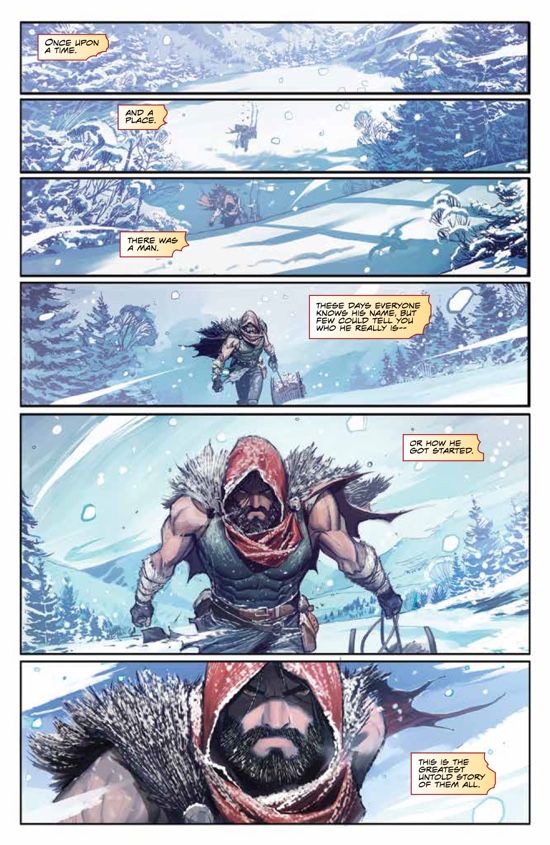
Alongside the epic Multiversity and other wildly esoteric superhero offerings, Glaswegian comic-writing shaman Grant Morrison seems to have turned to trying out mini-series with simple but arresting high-concepts worthy of Hollywood. Happy! for Image (grizzled corrupt cop sees the light courtesy of his imaginary friend, a blue horse) was one, and now comes six-part series Klaus. Described elsewhere as ‘Santa Claus: Year One’, this is a story which draws on Scandinavian and Siberian myth to tell a story which is raw and violent, yet with the beginnings of a distinctively – and literally – magical seasonal tale. Our hero is an (unnamed in the story) wild man seeking to trade his furs in the town of Grimsvig, formerly a "happy town". By order of the local Baron, fun is not allowed, and all toys are confiscated by the soldiers, for the amusement of the brattish Master Jonas. The stranger is run out of town, and saved from murder by his enormous white wolf Lilli; in a feverish, hallucinogenic trance (Mora, an interpreter of detailed, angular action elsewhere in the story excels here with wild streams of colour) he creates an array of beautiful toys. It’s a concept with great potential, and of course Morrison’s always a thrillingly exciting read, if sadly underrepresented when it comes to recognition in other media – by which we mean film adaptation. This is certainly a concept which could bring Morrison’s work belatedly to the screen. David Pollock

